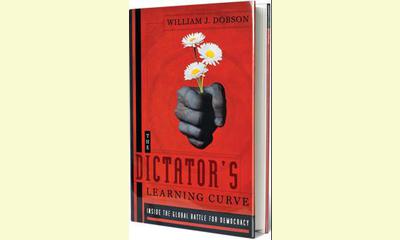|
|
Dictator’s Learning Curve: Inside the Global Battle for Democracy - A book review
un article par Janet Hudgins
What the Arab Spring has revealed is something
that young people, hardened activists, and
outspoken critics of these regimes had long known:
that in repressive countries around the world
there is a battle being waged between the ruler
and the ruled, a struggle between warring camps as
the future of democracy and dictatorship hangs in
the balance.

click on photo to enlarge
In his book, Dictator’s Learning Curve: Inside the
Global Battle for Democracy (Toronto, ON.
Doubleday, 2012), William J. Dobson puts on the
page what has been quietly going on in many parts
of the world for more than twenty years, quietly
because it is non-violent but earth-moving change,
a phenomenon in our time and a 180 degree
turnaround from the world’s history of a continuum
of declared and violent war. There were a long
series of government coups particularly since the
dissolution of the USSR in 1989 of which Dobson
chooses a few: Venezuela, Egypt, Tunisia, the
valiant but failed attempt in Tienanmen Square,
China. And he gives credit where it is due.
Youth, the vitally important youth, who are this
generation’s social justice seekers, are taking
instruction from the veterans of the last
generation’s experience and success in toppling
repressive regimes. It was a Tunisian, Mohamed
Bouazizi, who was harassed by the police to take
his fruit cart off the street, his only source of
income, and he subsequently burned himself alive
in the public square. With that, the ultimate
sacrifice, began the Arab Spring, the successful
overthrow of governments in Tunisia, Libya, Egypt,
and attempted in Bahrain and Syria. No one saw it
coming.
Country by country, Dobson relates how they are
bringing democracy and attempting to bring
democracy to their home. And why? Because there
are no jobs, the cost of living is too high and
beyond their reach, the global economy took their
jobs and sent them overseas, and there is labour
unrest. They are hungry, they are chronically
unemployed and they have no hope for their future.
And they despair of ever having a life that is any
better next year than it is now. Ironically, if
citizens were afforded a balanced life and their
rights were recognized, the dictatorship might go
on for another 30 years.
This is very recent history that Dobson is talking
about, unlike most analysts, these are wars still
going on, still in the making, and even some
expected, namely states in the Middle East. They
were ‘managing it’ with violence (at the time of
writing): Libya, Yemen, Iran, Syria. Other
autocrats in Saudi Arabia, Malaysia, Russia,
Venezuela and Burma, taking note of the Arab
Spring phenomenon were tightening up policies to
control uprisings before they happened.
The Dictator’s Learning Curve is a journal, an
easy read and sequentially written, each chapter
another dictator, depravity, corruption, and greed
the hallmark of these regimes. But, this account
of youth striving for reform exposes previous
generations as the slackers who allowed their
respective countries to come to this sorry state
in their history.
|








|
DISCUSSION
Question(s) liée(s) à cet article:
How can youth be engaged in democratic transitions?,
* * * * *
Commentaire le plus récent:
The youth in the article Democratic Transitions and the Role of Youth: A Debate are good examples:
Hilton Nyamukapa has recently taken part on a conference on Social Media and Youth Participation located in Amman, Jordan. Fatma Wakil has been actively involved within the Afghan community in the Netherlands as the chairperson of the KEIHAN, Afghan Youth Foundation. Yassine Boussaid is interested in connecting local issues to international organisations and improving the quality of life of the Moroccan and Turkish suburbs of Amsterdam.
Hilton concluded that it is necessary to the positive engagement and subscription of youth to democracy. The youth are often manipulated for a better picture in the media. Hilton cited the memorable injunction of the former President of USA, John F. Kennedy: "Ask not what your country can do for you--ask what you can do for your country." Hilton highlighted the urge to involve youth in the whole democratic process and give them the opportunity to participate in public life.

|
|









